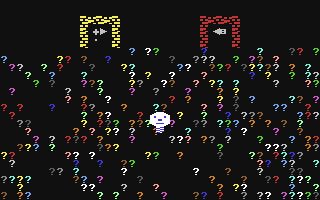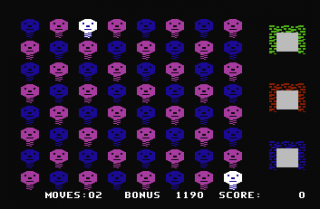Overview
Puzzle Panic is a 1984 puzzle game created by Ken Uston in collaboration with designers Ron Karr, Bob Polin, and Paul Wernick. Ken Uston was better known as a blackjack player and strategist, but he was also a video game author and the creator of Puzzle Panic. The game was originally released on the Commodore 64 and Atari 400/800 in 1984, but later received an MSX port in 1986 by SystemSoft.
Gameplay
 The first screen in an already puzzling game.
The first screen in an already puzzling game.Puzzle Panic is more of a minigame compilation than a defined puzzle game. There are eleven different "levels" that can be played, each of which is somehow a pattern based short puzzle game. These range from collecting certain items in a specific order, to reaching a set point under certain conditions.
The player begins the game in a room filled with question marks. There are two doors available, and walking into each one teleports the player to a new game (while the other brings the player to a new room, with two different doors; essentially a hub world). Within these games, there are several modes of difficulty to play through (accessed through three different doors within each game) before moving onto a different screen. All of the games can be accessed at anytime by bringing up the menu (by pressing F2).
When the games are played in order rather than by the menu selection, they are (in reality) part of a larger puzzle, where each puzzle is actually represented by its own symbol, and interaction with the gates at the end of each is integral. In fact, the final puzzle requires the player to select the symbol that represents each level, as well as the order they were played in sequence. The final puzzle was known as "Metasequence," Ken Uston's "ultimate challenge." This larger puzzle was originally intended to be part of a real life contest, where players who managed to complete the puzzle in time (by August 31, 1984) won a trip to Atlantic City with Ken Uston.
Games
Black & White (Modes A and B)
This game has two different types of play (and thus, is either A or B on the menu). The A mode has players collecting all of the shapes in order (e.g. triangles, then squares, then hexagons, and so on), while the B mode has players collecting all of the shapes in no particular order. Picking up a shape of one type causes one of the next to spawn. This all has to be done while simultaneously dodging a red devil, which causes instant death upon being touched. It is notable the Black & White is the only game to give the player lives.
Computer Response (Mode C)
 Randomized teleportation is always fun.
Randomized teleportation is always fun.The C on the menu selection is Computer Response, a game where the player must guide the main character (Benny) from the top left of the screen to the bottom right. This is done by moving either up, down, left, or right. However, each move also has a secondary effect; moving Benny in another direction as well. In the first difficulty, this means that moving to the right will teleport Benny one square down after moving left, moving right causes a transverse effect, moving up teleports Benny right, and moving down causes a transverse effect. This teleportation is escalated as difficulty progresses.
Sound Chase (Mode D)
A "Simon Says"-esque game, Sound Chase requires Benny to match the movements of a yellow square. The square moves around a 12x26 grid, with each movement creating a different sound. Each movement is increasingly complex in both length and movement.
Color Climb (Mode E)
 Color Climb is one of the game's two timed levels.
Color Climb is one of the game's two timed levels.One of the few timed games, Color Climb puts Benny on a player field consisting of colored rectangles and several colored arches at the top of the screen. The arches determine which color Benny is able to climb up, as each row of rectangles contains one of each color (red, blue, green, yellow, cyan, and pink). For example, when the color of the arches is yellow, Benny can only climb up yellow rectangles. Once Benny is in a row, he can move freely throughout it, he can only progress vertically when the color is matching.
Card Sequence (Mode F)
A game which hearkens back to Ken Uston's blackjack roots, Card Sequence puts stacks of five cards out onto the playing field. Only four cards in each stack is visible. Then, one card is displayed to the top left. The player must match that card to the sequences displayed, as that card is the hidden card in one of the four sequences. For example, if four of the five cards displayed are "4, 5, 6, and 7," and the card to the top right is "8," then those two will be matches.
Number Sequence (Mode G)
 As if solving this game's purpose wasn't hard enough...
As if solving this game's purpose wasn't hard enough...Similar to Color Climb, this is one of the two timed games. Number Sequence displays a large colored square in the center of the screen, and several smaller colored rectangles scattered around the stage. The player must uncover the colored rectangles when the color in the center matches (e.g. if the color in the center is red, red rectangles can be uncovered). When uncovered, a number is displayed, and when time runs out a number flashes in the center. The player must find that number. This all must be done while dodging a yellow enemy.
Memory Test (Mode H)
The game starts with Benny uncovering numbers one through four. These transform into colored squares, which are then reorganized. Benny must match these up in the same order they were uncovered, uncovering different shapes or different colors. For example, uncovering the initial colored squares may reveal a triangle, a pentagon, a hexagon, and a square (all of the same color), and those must be matched up in the same order they were uncovered.
Puzzling Polygons (Mode I)
 The player must pick up the shapes in order of least sides to greatest sides.
The player must pick up the shapes in order of least sides to greatest sides.Very similar to Black & White, Puzzling Polygons requires players to pick up each polygon in ascending order (by number of sides). However, unlike Black & White, all of the polygons are bouncing off of the walls around the room, so the player must dodge some polygons in order to pick up the correct ones.
Music Mimic (Mode J)
In this game, a musical cue is played and then the player is attacked by a green enemy. In order to win, the player must play the musical cue using the musical notes on the playing field, whilst simultaneously dodging the green enemy.
Raccoons (Mode K)
 Raccoons is pretty random in a game filled with math and logic.
Raccoons is pretty random in a game filled with math and logic.In Raccoons, there are four raccoons and a red enemy. The player must touch the raccoon different from the rest (e.g. with a blinking white eye), while dodging the other raccoons and the red enemy. When all four raccoons are gathered (once one is touched, a different one has a difference), the game is finished, and progresses in difficulty.
Log in to comment